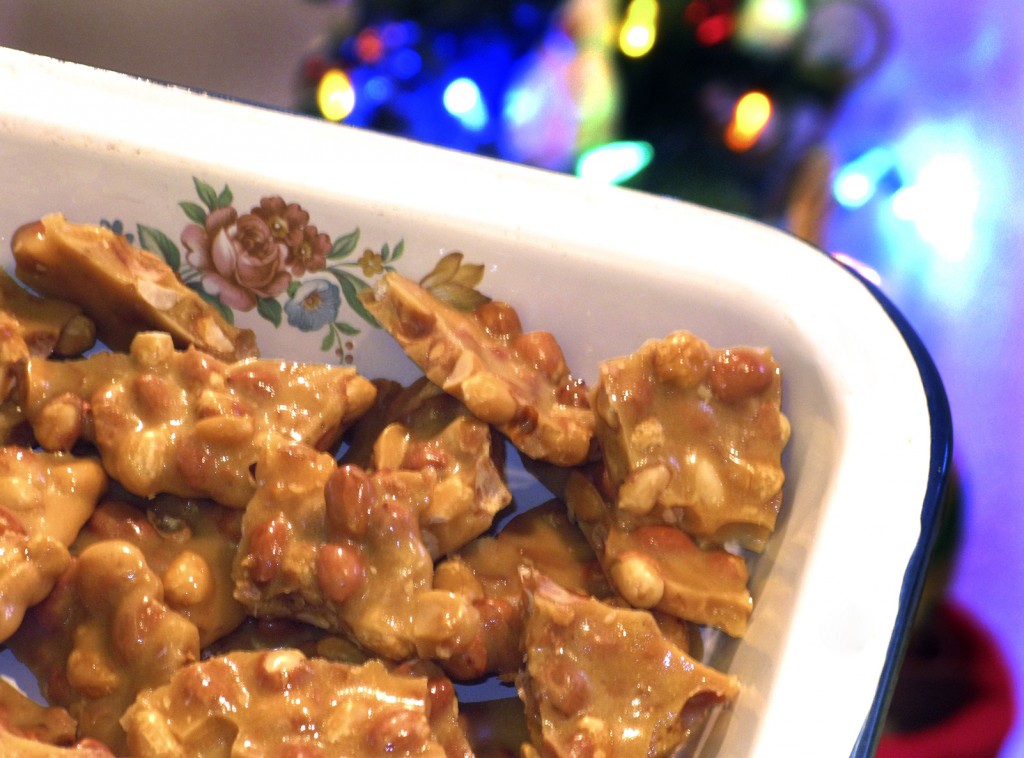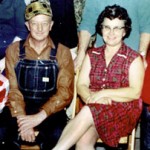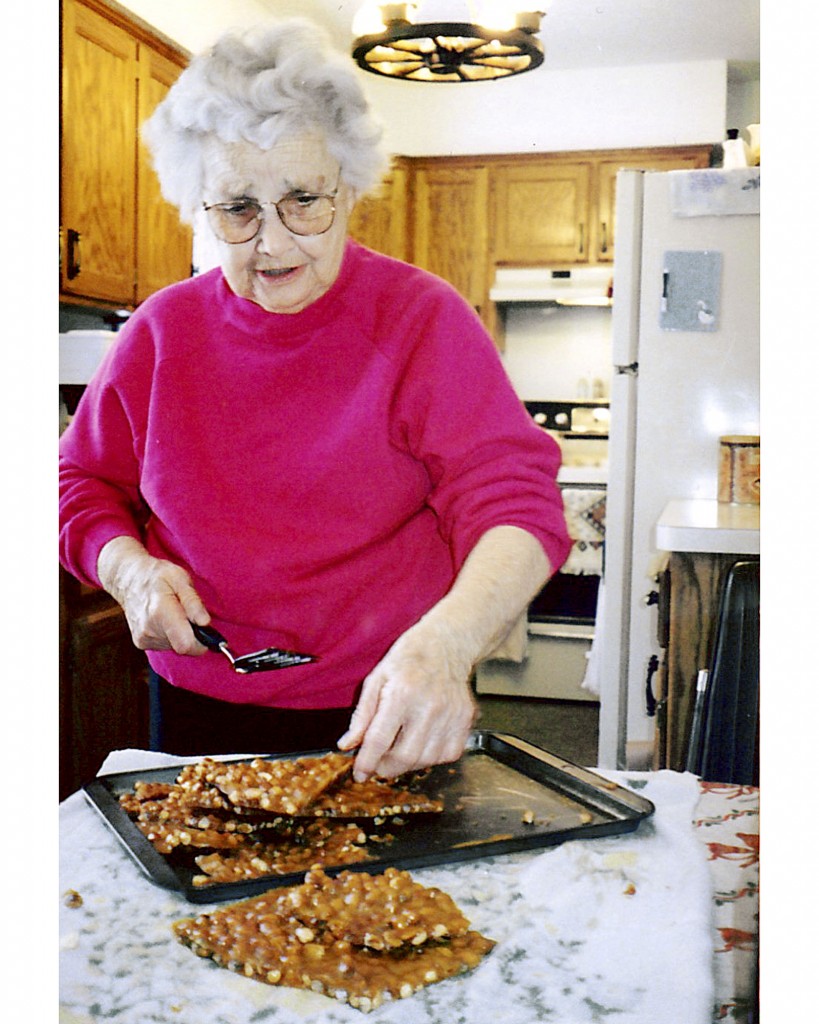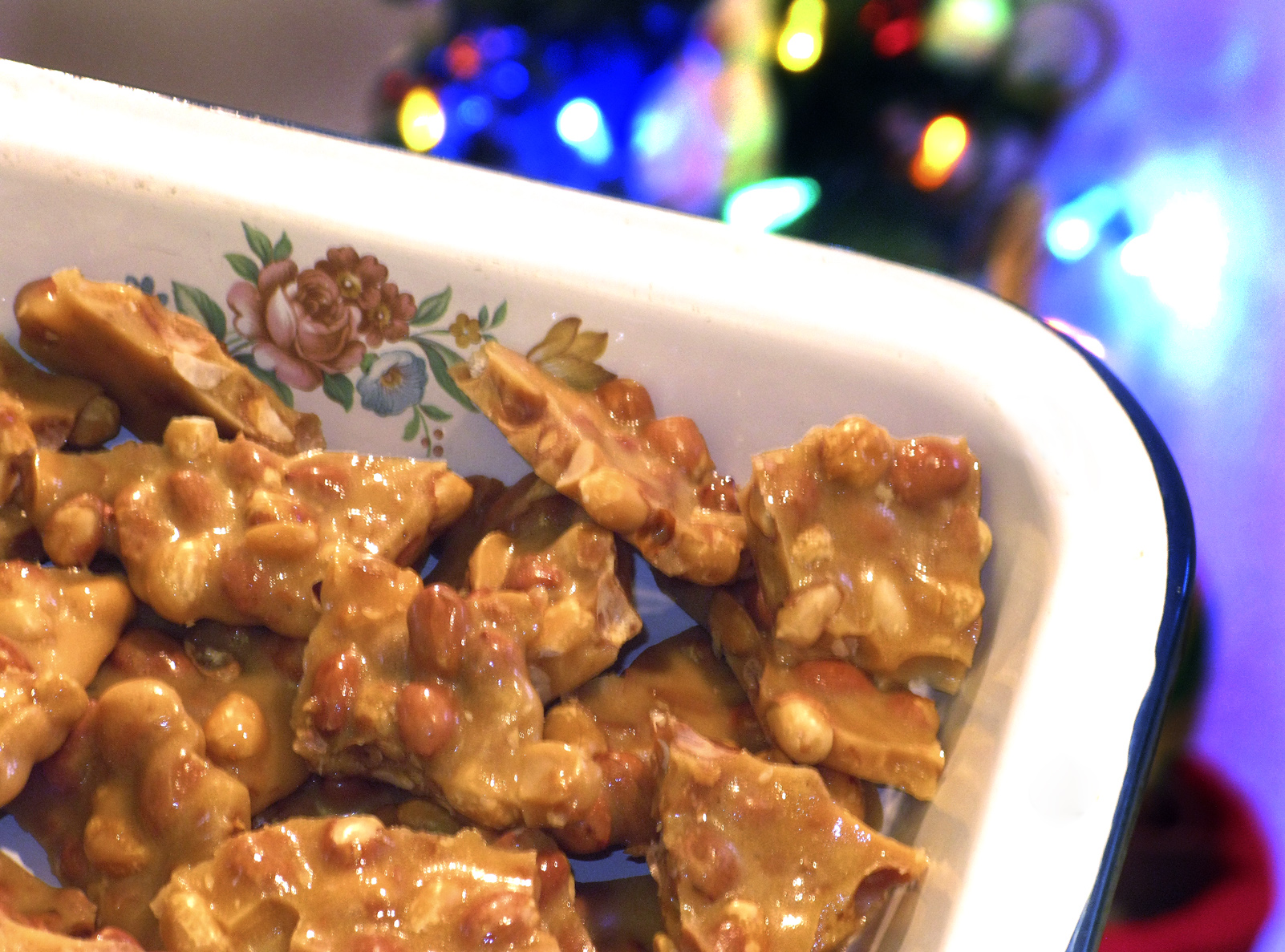
My late Grandma Mae called my parents nearly every day until her death in 2008 at the age of 92. Her inquiries were nearly always the same: “What’s new?†“What’s the weather doin’ over there?†“How’s your firewood holding up?†But one of her predominant questions was as much to affirm as to ask: “Whatcha havin’ good to eat?â€
She was assuming we were not only eating, but eating well, as most of my family does. And not just eating anything, but something that we had fixed. Grandma knew this because she practiced it herself. The food was the thing and food was love. And if you’re going to eat anything, it better be good. She made good food, much of it from scratch, but was not ashamed of shortcuts – of soup mixes to season chicken and noodles or short ribs; of cake mix to make her famous cherry “crispy.†She even let Mrs. Smith bake pies for her every once in awhile. This sounded easy, but there was a skill to making the right choices. She knew enough about taste to take the seasoning packet from one stuffing mix and add it to the bread cubes of another. All her food tasted right. I asked her once how she learned to season everything properly, “It takes time,†she said. It could take much of your life to get it right.
Grandma Mae had spent much of her life feeding people. She was a worrier about many things, but cooking was not one of them. There were early years in poverty where having food to cook was a worry, when hunting and fishing kept the family alive, when she pushed a baby buggy full of carp and brought my father along as a little boy to help her sell them on the streets of Junction City, Kansas.
Perhaps she got all her worry about food out of her then because by the time I was aware of her, she cooked and fed with ease and had raised six children and now had 11 grandchildren (who would eventually produce 18 great-grandchildren, and then we stopped counting). Sundays, if family dropped in, and most of them usually would, she’d say simply, “Let’s have us a snack.†Then she would proceed to bring out plates of roast beef, ham, cheeses, sliced tomatoes, pickles and more. There would usually be a lemon Bundt cake or a sweet of some kind. She’d greet folks at the kitchen door, her apron a dishtowel tucked into the front waistband of her pants. She’d smooth out the entryway rag rug with her small foot and say, “Come on in.â€
 She was fiercely loyal to family, protective of them. This began, I think, because of a gentle older sister who was teased and bullied by other children, who were promptly pounced upon by my tiny but potent grandmother, the mighty Rosa Mae, who would spend enough time with them to give them something to think about. As she grew up and started her own family and it continued to expand, she was always more at home in the company of family than strangers. She spoke her mind – perhaps a little too freely – with family, often with humor, but sometimes with harshness. She liked to tell family what they should do and this ruffled more than one of us throughout the years. We learned to live with it, and she learned to live with our resistance to it. It was her way of protecting her brood. She lived for the times when the brood gathered.
She was fiercely loyal to family, protective of them. This began, I think, because of a gentle older sister who was teased and bullied by other children, who were promptly pounced upon by my tiny but potent grandmother, the mighty Rosa Mae, who would spend enough time with them to give them something to think about. As she grew up and started her own family and it continued to expand, she was always more at home in the company of family than strangers. She spoke her mind – perhaps a little too freely – with family, often with humor, but sometimes with harshness. She liked to tell family what they should do and this ruffled more than one of us throughout the years. We learned to live with it, and she learned to live with our resistance to it. It was her way of protecting her brood. She lived for the times when the brood gathered.
During the holiday season, the mind invariably strolls backward to the seasons of childhood, of Christmases past, and rarely – well, never – was a Christmas of my youth spent without the company of Grandma Mae. There was nothing more constant, expected and consistent than the Christmases at my grandparents.  Grandma loved Christmas and each year hurried toward it. Oddly enough, she hurried out of it, too. Every year, after the presents had been opened and Grandpa had, rattling voice grumbling, collected the trails of torn-up wrappings and burned them in a barrel in the yard (and tragically, one year, incinerated a toy or two in his haste. He was refreshingly unapologetic about this…more on him later), and we had conga-lined our way down a noon buffet laden with ham, turkey, dressing, potatoes, gravy, corn, dinner rolls and an array of crisps, pies and cakes, Grandma would announce, “Well, Christmas is over for another year.†This dismayed a young child who, not only having learned to read the sun but also the hands of the many clocks ticking away in Grandma’s kitchen, knew that almost half of Christmas Day still lay ahead. Still, Grandma — like most of the population, unfortunately – thought the significant aspects of the day were done. She was just one of the few who had the courage to say it.
Grandma loved Christmas and each year hurried toward it. Oddly enough, she hurried out of it, too. Every year, after the presents had been opened and Grandpa had, rattling voice grumbling, collected the trails of torn-up wrappings and burned them in a barrel in the yard (and tragically, one year, incinerated a toy or two in his haste. He was refreshingly unapologetic about this…more on him later), and we had conga-lined our way down a noon buffet laden with ham, turkey, dressing, potatoes, gravy, corn, dinner rolls and an array of crisps, pies and cakes, Grandma would announce, “Well, Christmas is over for another year.†This dismayed a young child who, not only having learned to read the sun but also the hands of the many clocks ticking away in Grandma’s kitchen, knew that almost half of Christmas Day still lay ahead. Still, Grandma — like most of the population, unfortunately – thought the significant aspects of the day were done. She was just one of the few who had the courage to say it.
Christmas fare was standard and predictably delicious, as was the candy Grandma distributed around the house on the holiday. In lidded and open glass dishes of varying degrees of feminine antiquity, Grandma presented colorful purchased ribbon candy and ghostly divinity (a creature she loved…still hard for me to fathom) and plates of homemade peanut butter and chocolate fudge. But the true concoction that made my Grandma a star was her peanut brittle – crispy, buttery and loaded with peanuts; everyone made a beeline for these confectionary honeycombs at Christmas (some, so much, that she hid a little back from them…like her, I’ve inherited a desire to feed people, but have a low tolerance for gluttony).
After I grew up and moved away, not all of my Christmases were spent with Grandma. Those times, a package would arrive heavy with a Ziploc bag stuffed with her peanut brittle, sturdy enough to withstand the U.S. Postal Service. The golden nuttiness took me home.
Some 10 years ago, the year before my Grandma broke her hip (an event which changed her irreversibly to someone much more solemn and sedate, who no longer cooked), I asked her if I could come watch her make peanut brittle and find out how it’s done. I’m not sure anyone in the family had ever asked her to show them how to make anything, but she was delighted to have my mother and I come over that cold and cloudy December afternoon. She had always supported my attempts to be a writer (even though I was defying her notion that lady folk should get married and reproduce) and probably assumed correctly that I was on a fishing expedition. Of her past, she never gave up details very easily. Of her peanut brittle, she opened the door – dishtowel in her pants – smoothed out the rug and said, “Come on in.â€
She cooked her peanut brittle as she cooked everything, as if she was paying it no mind. This was deceptive – she knew exactly what she was doing because she had done it so many hundreds of times that it was as natural as falling asleep and waking up again. I remember Christmases where the house was full of people meandering through the kitchen, children in the way and pots were a-steam on the stove, and she went about getting everything ready calmly and steadily. A gravy was at such a high boil one year that the roaster began to tip back and forth with heat. “Grandma! Your gravy pan’s rocking!†one of my cousins yelled, not helping in any way.“Well, let ‘er rock,†Grandma responded, carrying on with the potato whipping. It would all be all right.

This day of brittle making, Grandma already had her sugar, corn syrup and water in the heavy old kettle on the stove; peanuts, butter, baking soda and vanilla awaited their turn on the counter. The recipe she used came from the back of the package of raw Spanish peanuts. She had made her brittle the same way for years, straying only once to make a version in the microwave. It had been a huge disaster, unfit for she and my uncle to eat. They fed it to the dogs and it caused the poor creatures’ jaws to be temporarily glued shut. “They came to the door and all they could do was grin at us,†Grandma recalled.
As her sugar syrup boiled, Grandma sat and chatted, telling the latest doings of family members. I wondered if she should be watching the pot. “You just let it berl, berl, berl,†she sang. She’d get up occasionally and give it a stir, then go back to conversing as if she was not cooking anything. She was dressed in bright colors, as usual, and her kitchen was spotless, smelling as it always had of the strangely appealing combination of lemon dishwashing soap and ham. Chickens dotted the landscape – a chicken box on the wall for matches, a wooden bin with chickens on the lid contained the wastecan. (Today, my kitchen is full of chickens, including the chicken salt and pepper shakers from Grandma’s stove…I left the salt and pepper from her days in them.)
The big moment came to add the peanuts and butter, and my little Grandma fearlessly plunged her arm and spoon down into the big hot kettle to stir the nutty lava. “Now, you cook it ‘til it’s almost burnt,†she said.
Off the stove and in went the baking soda and vanilla. The mixture foamed up. Grandma turned it out onto cookie sheets and spread it into even slabs. A few clumps of the candy clung to Grandma’s hot pink sweatshirt. She pulled them off and crunched them down. “It’s good,†she said, not sounding surprised. Why would she be?
This past Christmas Eve, my Grandma now gone for more than two years, I decided to honor her Christmas tradition and try to make peanut brittle. It had been a long time since that day she showed me her brittle making. If I’d written down the recipe, I couldn’t find it, but I knew what she made was basic and traditional, so I turned to Betty Crocker’s recipe for my own experience. I’d made other candy and knew weather and other factors can sometimes make it a delicate dance. Fortunately, I had a dry day and a happy heart as I put the pot on, mixed my corn syrup, sugar and water in it and commenced to let it berl, berl, berl.
Of course, I was not as relaxed about it as she was – I hovered over the stove and waited. I had a legacy to live up to, and on top of that, I couldn’t find my candy thermometer. But Grandma didn’t use one, either. So I dripped test drops of the candy into cold water, waiting for the “soft ball†stage. Having gotten to that point, I added the butter and peanuts, stirring furiously. The mixture looked too blonde, and I knew if I was too tenuous about the color, the brittle would not turn out, well, brittle. Suddenly, I could see my Grandma’s bright blue eyes at the bottom of that pot, amid the peanuts, and heard her telling me: “Cook it ‘til it’s almost burnt.â€

I did, and I did not go too far. The candy frothed up beautifully when the elixir of vanilla and baking soda hit it and it spread out agreeably into beautiful golden brown slabs onto two buttered pans. I crunched some of the leavings in the pot. Damn! Grandma would be proud…
She is gone, but she is not gone. This, I know, sounds ultra cliché. But she weighs heavy in my memory to the point of still being present. I can carry myself back to the childhood Christmases with ease, along with the later years when I accompanied her to church and heard her high voice plummet to the bottom of the scale as she sang, “Love Lifted Me.†And as I grow older, she comes out of me all the time with a little laugh or expression, with my penchant for bright colors and my ever-burgeoning sassiness. Perhaps I’ll relax as a cook, too. “It takes time,†she told me. It could take the rest of my life, and that’s all right. And now that she is no longer here to ask it, I’ll continue to pose her question: “Whatcha havin’ good to eat?â€
Peanut Brittle
(from Betty Crocker’s Cookbook)
1 ½ teaspoon baking soda
1 teaspoon water
1 teaspoon vanilla
11/2 cups sugar
1 cup water
1 cup light corn syrup
3 tablespoons butter or stick margarine
1 pound unsalted raw Spanish peanuts (3 cups)
Heat oven to 200 degrees. Grease two cookie sheets, 15 ½ by 12 inches, with butter; keep warm in oven. (Keeping the cookie sheets warm allows the candy to be spread ¼-inch thick without it setting up.) Grease long metal spatula with butter, set aside.
Mix baking soda, 1 teaspoon water and the vanilla, set aside. Mix sugar, 1 cup water and the corn syrup in a 3-quart saucepan. Cook over medium heat, about 25 minutes, stirring occasionally, to 240 degrees on candy thermometer or until small amount of mixture dropped into cup of very cold water forms a soft ball that flattens when removed from water.
Stir in butter and peanuts. Cook about 13 minutes, stirring constantly, to 300 degrees or until small amount of mixture dropped into cup of very cold water separates into hard, brittle threads. (Watch carefully so mixture does not burn.) Immediately remove from heat. Quickly stir in baking soda mixture until light and foamy.
Pour half of the candy mixture onto each cookie sheet and quickly spread about ¼ inch thick with buttered spatula. Cool completely, at least 1 hour. Break into pieces. Store in airtight container. Makes about 6 dozen pieces.
Guest Kitchen will be a semi-regular feature on this blog highlighting the kitchens and specialties of other cooks.
